

Bubbl.us - brainstorm and mind map online. ALISON: Free Online Courses. Higher Education Academy Engineering Subject Centre. 10 Ways or Techniques to Help Improve Critical Thinking. Leadership Hiring – Critical Thinking is the key. It is easy to identify critical thinkers once they have exhibited good problem solving and decision making skills.
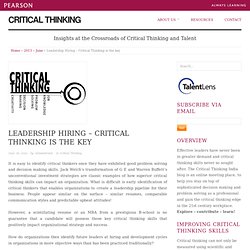
Jack Welch’s transformation of G E and Warren Buffett’s unconventional investment strategies are classic examples of how superior critical thinking skills can impact an organization. PBL. CRITICAL THINKING. A primary task of any educational institution is to develop the students who go there.

Development may take many forms, but the main goal of the Army Management Staff College (AMSC) is the development of leadership, management, and decision making skills. We believe that underlying these skills is the ability to exercise consequential/critical thinking. (For the sake of convenience, we hereafter just use "critical thinking . ") Although we include critical thinking in all the College’s programs, my remarks in this paper will be addressing the Sustaining Base Leadership and Management Program. Critical Thinking Skills - Kaplan Open Learning. Developing Critical Thinking Skills in Distance Education.wmv. What Is Active Learning? Defining "active learning" is a bit problematic.
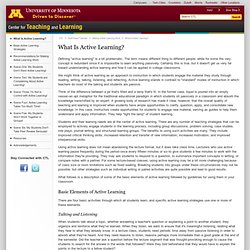
The term means different thing to different people, while for some the very concept is redundant since it is impossible to learn anything passively. Certainly this is true, but it doesn't get us very far toward understanding active learning and how it can be applied in college classrooms. We might think of active learning as an approach to instruction in which students engage the material they study through reading, writing, talking, listening, and reflecting. Active learning stands in contrast to "standard" modes of instruction in which teachers do most of the talking and students are passive. Think of the difference between a jar that's filled and a lamp that's lit. Course Design - Higher Order Thinking.
Bloom’s Taxonomy and Higher Order Thinking As explained in Course Design Overview, one of the major tasks in designing a course is to determine important learning outcomes.

The learning outcomes would appear in your syllabus as course goals and specific objectives. Before you set out to write your course goals and objectives, it is very helpful to understand Bloom’s taxonomy and higher order thinking (HOT). Benjamin Bloom (1913-1999) is an educational psychologist who led the effort in developing a taxonomy that served as a framework for classifying learning objectives, i.e., what we expect students to learn as a result of instruction.
Memory Storage - Memory Processes. Storage is the more or less passive process of retaining information in the brain, whether in the sensory memory, the short-term memory or the more permanent long-term memory.

Each of these different stages of human memory function as a sort of filter that helps to protect us from the flood of information that confront us on a daily basis, avoiding an overload of information and helping to keep us sane. The more the information is repeated or used, the more likely it is to be retained in long-term memory (which is why, for example, studying helps people to perform better on tests). This process of consolidation, the stabilizing of a memory trace after its initial acquisition, is treated in more detail in a separate section. Since the early neurological work of Karl Lashley and Wilder Penfield in the 1950s and 1960s, it has become clear that long-term memories are not stored in just one part of the brain, but are widely distributed throughout the cortex.
Developing critical thinking. It means not taking what you hear or read at face value, but using your critical faculties to weigh up the evidence, and considering the implications and conclusions of what the writer is saying.
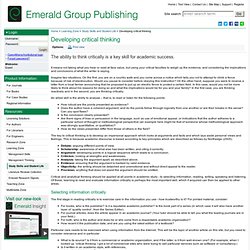
Imagine two situations. On the first, you are on a country walk and you come across a notice which tells you not to attempt to climb a fence because of risk of electrocution. Would you pause to consider before obeying this instruction? On the other hand, suppose you were to receive a letter from a local farmer announcing that he proposed to put up an electric fence to protect a certain field. DEVELOPING AND DOCUMENTING PROBLEM SOLVING SKILLS: Web-Based Tutorial Introduction Identifying Framing Resolving Re-Addressing Exercises Evaluation Form Tutorial for Optimizing and Documenting Open-Ended Problem Solving Skills Ó January 2000, Cindy Lynch, Susan Wolcott, and Greg Huber Permission is granted to reproduce this information for noncommercial purposes.
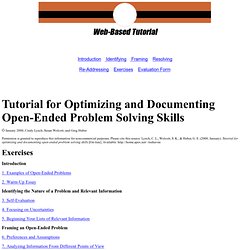
Exercises. Idea_Paper_37. The reflective learning process. CM365: Developing Critical Thinking Skills. The following unit focuses on the four specific tests an argument must pass in order for a critical thinker to consider it worthy as proof that its conclusion is (very probably) true.
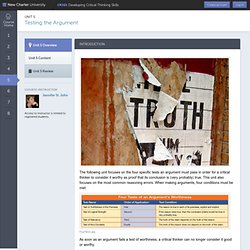
This unit also focuses on the most common reasoning errors. When making arguments, four conditions must be met: As soon as an argument fails a test of worthiness, a critical thinker can no longer consider it good or worthy. Truthfulness is always the first test because if a premise is untrue, there is little point in moving forward to evaluate any other aspect of the argument. However, most people offer multiple premises in support of an argument, so a critical thinker cannot dismiss an entire argument simply because one of its premises is false when other premises are true. Reading Comprehension Worksheets.
"Your reading comprehension materials are the best I've found on the web.

They are so thorough and comprehensive! My students and I have learned a lot from them. Create Engaging E-Learning Courses You Can Be Proud Of. Everyone wants to create e-learning courses that engage their learners.
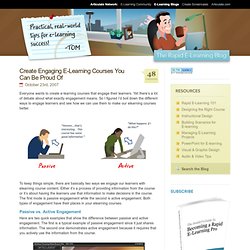
Yet there’s a lot of debate about what exactly engagement means. So I figured I’d boil down the different ways to engage learners and see how we can use them to make our elearning courses better. To keep things simple, there are basically two ways we engage our learners with elearning course content. Either it’s a process of providing information from the course or it’s about having the learners use that information to make decisions in the course. The first mode is passive engagement while the second is active engagement. AMICUS. Case Study Presentation Rubric - N994X3. Kolb's Learning Style Inventory & How to Use It Effectively. Memory, Retention, and Learning. HowToWriteObjectivesOutcomes.pdf (application/pdf Object) Smart.pdf (application/pdf Object) Make online flashcards & notes. Study anywhere, anytime. Verbling. Teacher & Student Planners. Advanced Plagiarism Checker. Introduction to Plagiarism Checker Search Engine Report Plagiarism Checker is the best free anti-plagiarism checker that is available online today.
Made with proper research on what the customers are looking for in a free plagiarism detection system, we have implemented all the strategies and tools required to make this the best anti-plagiarism checker for everyone. We understand that students use plagiarism checkers to check for plagiarism in their papers, essays, and reports before submission. Hence, the Search Engine Report Plagiarism Checker has specifically designed a system to help the students go through their reports.
Same goes for teachers, this tool is very helpful if they want to check uniqueness of the work submitted to them. Search Engine Report Plagiarism, also given the name of “best plagiarism checker for students†and “the best free college plagiarism checker†by many, has earned its title over the years after consistently serving so many users across the globe. RubiStar Home.
Essay Map. University of Minnesota Libraries - Assignment Calculator. Note-Taking Templates « Library Learning Commons. Info.